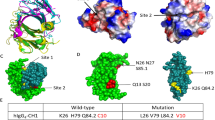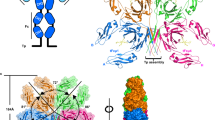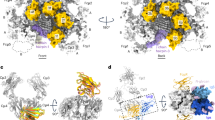Abstract
IgM and IgG are the only classes of immunoglobulin capable of initiating the classical complement cascade. IgM, however, fixes complement much more effectively than IgG making it a more attractive Fc for some immunotherapeutic strategies. IgG, on the other hand, triggers additional effector functions mediated through γ specific Fc receptors. Using a generalizable technique we have produced IgM-like polymers of IgG that possess both the Fcγ receptor binding properties of IgG and the more potent complement activity of IgM.
This is a preview of subscription content, access via your institution
Access options
Subscribe to this journal
Receive 12 print issues and online access
$209.00 per year
only $17.42 per issue
Buy this article
- Purchase on Springer Link
- Instant access to full article PDF
Prices may be subject to local taxes which are calculated during checkout
Similar content being viewed by others
References
Shenoy, A.M. and Brahtni, Z. 1989. Human IgGl and mouse IgG3 but not monomeric IgM or IgE facilitate antibody-dependent cell-mediated cytotoxicity by human natural killer cells. Nat. Immun. Cell Growth Regul. 8: 338–48.
Bruggemann, M., Teale, C., Clark, M., Bindon, C. and Waldmann, H. 1989. A matched set of rat/mouse chimeric antibodies. Identification and biological properties of rat H chain constant regions mu, gamma 1, gamma 2a, gamma 2b, gamma 2c, epsilon, and alpha. J. Immunol. 142: 3145–50.
Vieira, P. and Rajewsky, K. 1988. The half-lives of serum immunoglobulins in adult mice. Eur. J. Immunol. 18: 313–6.
Davis, A.C., Roux, K.H., Pursey, J. and Shulman, M.J. 1989. Intermoiecular disulfide bonding in IgM: effects of replacing cysteine residues in the mu heavy chain. EMBO J. 8: 2519–26.
Kabat, E.A., Wu, T.T., Reid-Miller, M., Perry, H.M. and Gottesman, K.S. 1987. Sequences of Proteins of Immunological Interest, 4th ed. U. S. Department of Health and Human Services, Washington, DC.
Dangl, J.L., Wensel, T.G., Morrison, S.L., Stryer, L., Herzenberg, L.A. and Oi, V.T. 1988. Segmental flexibility and complement fixation of genetically engineered chimeric human, rabbit and mouse antibodies. EMBO J. 7: 1989–94.
Oi, V.T. and Morrison, S.L. 1986. Chimeric Antibodies. BioTechniques 4: 214–221.
Shin, S.U. and Morrison, S.L. 1989. Production and properties of chimeric antibody molecules. Methods Enzymol. 178: 459–76.
Tao, M.H. and Morrison, S.L. 1989. Studies of aglycosylated chimeric mouse-human IgG. Role of carbohydrate in the structure and effector functions mediated by the human IgG constant region. J. Immunol. 143: 2595–601.
Uzgiris, E.E. and Kornberg, R.D. 1983. Two-dimensional crystallization technique for imaging macromolecules, with application to antigen—antibody—complement complexes. Nature 301: 125–9.
Feinstein, A., Richardson, N.E., Gorick, B.D. and Hughes-Jones, N.C. 1983. Immunoglobulin M conformational change is a signal for complement activation, p. 47–57. In: Protein Conformation as an Immunological Signal. F. Celada, V. N. Schumaker and E. E. Sercarz (Eds.). Plenum Press, New York.
Burton, D.R. and Woof, J.M. 1992. Human antibody effector function. Adv. Immunol. 51: 1–84.
Tan, L.K., Shopes, R.J., Oi, V.T. and Morrison, S.L. 1990. Influence of the hinge region on complement activation, C1q binding, and segmental flexibility in chimeric human immunoglobulins [published erratum appears in Proc. Natl. Acad. Sci. USA 1991 Jun 1;88 (11): 5066]. Proc. Nad. Acad. Sci. USA 87: 162–6.
Shuford, W., Raff, H.V., Finley, J.W., Esselstyn, J. and Harris, L.J. 1991. Effect of light chain V region duplication on IgG oligomerization and in vivo efficacy. Science 252: 724–7.
French, D.L., Pollock, R.R., Aguila, H.L. and Scharff, M.D. 1991. The molecular and biochemical characterization of mutant monoclonal antibodies with increased antigen binding. J. Immunol. 146: 2010–6.
Shopes, B. 1992. A genetically engineered human IgG mutant with enhanced cytolytic activity. J. Immunol. 148: 2918–22.
Caron, P.C., Laird, W., Co, M.S., Avdalovic, N.M., Queen, C. and Schein-berg, D.A. 1992. Engineered humanized dimeric forms of IgG are more effective antibodies. J. Exp. Med. 176: 1191–5.
Sitia, R., Neuberger, M.S. and Milstein, C. 1987. Regulation of membrane IgM expression in secretory B cells: translational and post-translational events. EMBO J. 6: 3969–77.
Sitia, R., Neuberger, M., Alberini, C., Bet, P., Fra, A., Valetti, C., Williams, G. and Milstein, C. 1990. Developmental regulation of IgM secretion: the role of the carboxy-terminal cysteine. Cell 60: 781–90.
Tao, M.H., Smith, R.I. and Morrison, S.L. 1993. Structural features of human immunoglobulin G that determine isotype-specific differences in complement activation. J. Exp. Med. 178: 661–7.
Hughes, J.N. and Gardner, B. 1979. Reaction between the isolated globular sub-units of the complement component C1q and IgG-complexes. Mol. Immunol. 16: 697–701.
Zoller, M.J. and Smith, M. 1984. Oligonucleotide-directed mutagenesis: a simple method using two oligonucleotide primers and a single-stranded DNA template. DNA 3: 479–88.
Boulianne, G.L., Hozumi, N. and Shulman, M.J. 1984. Production of functional chimaeric mouse/human antibody. Nature 312: 643–6.
Author information
Authors and Affiliations
Rights and permissions
About this article
Cite this article
Smith, R., Morrison, S. Recombinant Polymeric IgG: An Approach to Engineering More Potent Antibodies. Nat Biotechnol 12, 683–688 (1994). https://doi.org/10.1038/nbt0794-683
Received:
Accepted:
Issue Date:
DOI: https://doi.org/10.1038/nbt0794-683



